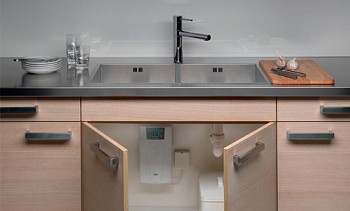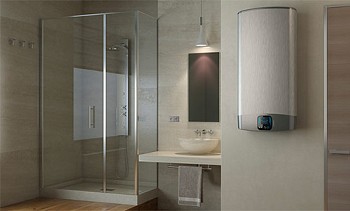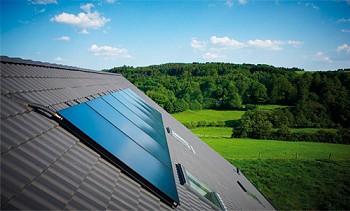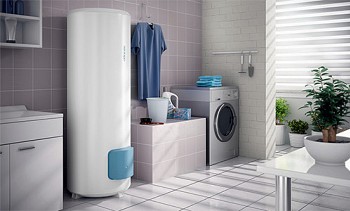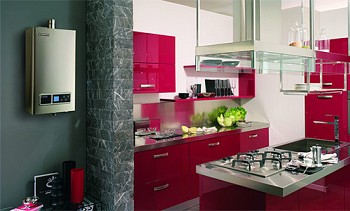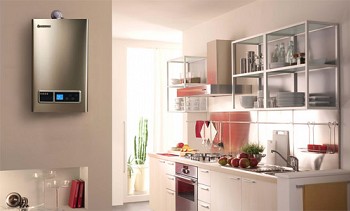Which water heater is better flowing or storage - a detailed comparison
Almost all modern water heaters operate either on electricity or on gas. Other options, including solid and liquid fuel appliances, can be attributed to the exotic, in any case, in the category of climatic equipment designed for domestic use, you will not find anything like this.
Both gas and electric water heaters, in turn, are divided into storage and flow. The former prepare a sufficiently large volume of hot water in advance, after which they can only maintain its temperature and warm it up as it is consumed.
The second ones work in real time, i.e. start to heat water only when the user turns the faucet on his mixer. It should be noted that gas storage water heaters are not widespread in the modern market, and therefore we will not consider them in our review.
So, in reality there are not so many options - accumulative electric, flowing electric and flowing gas. The choice between electricity and gas depends primarily on the availability of the latter. But the question is, which water heater is better - flowing or storage, not so simple. To find the answer to it, you need to understand a lot of nuances - the principles of work, design features, existing restrictions, the specifics of operating conditions.
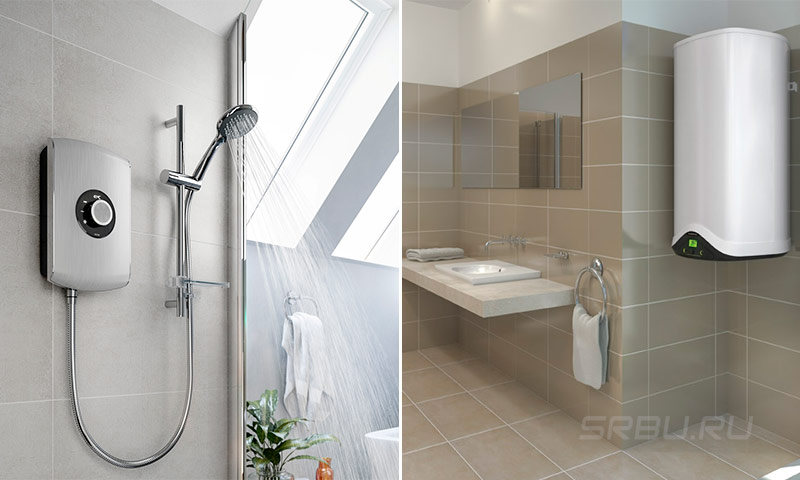
Content:
- What is the difference between flowing and storage types of water heaters
- Dimensions and weight of the device
- Profitability and cost of water heating
- The need for engineering systems
- The ability to produce the required amount of water at any time of the year
- Installation complexity
- Service requirement
- Comparison Table
- In which cases it is advisable to use one or another water heater
What is the difference between flowing and storage types of water heaters
In terms of their structure and principle of operation, all water heaters are not much different from heating boilers, but their power is less. No wonder. The boiler is operated only during the heating season, but in the cold it is forced to work non-stop around the clock. There is a need for hot water at any time of the year, but they actually use it only several times during the day, which means that a large capacity is not required from a water heater.
Gas water heaters
If your house is not gasified, then it makes no sense to talk about the advantages and disadvantages of using gas as a source of energy necessary for heating water. Owners of private houses in which there is a gas supply very often prefer gas water heaters. They are more difficult to install and maintain, but they guarantee significant savings, because the cost of heating water with gas is several times lower.
Gas water heaters are in many ways similar to gas heating boilers, but in comparison with them they have a simpler design: the heater also has a burner and a heat exchanger, but it does not need a pump for water circulation, an expansion tank and a number of other structural elements. Like heating boilers, water heaters can be convection and condensation. However, the latter is only in theory: capacitors are not used in everyday life - they are too expensive and, with a few percent savings, are unlikely to pay for themselves.
Gas water heaters, like electric ones, can be instantaneous and storage. However, the latter are very rare; similar models are offered by only a few manufacturers.
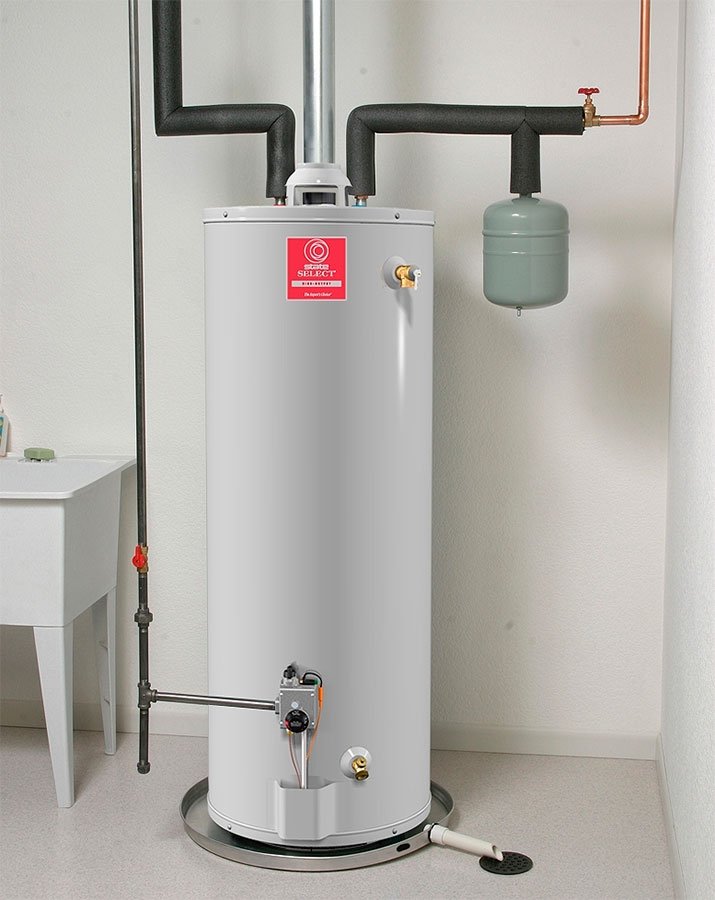
Accumulative gas water heater.
It is not surprising that the desire to purchase bulky and expensive storage gas heaters does not arise from the average use. So, it’s pointless for us to talk about them either.
The capacity of a gas-fired gas water heater is quite sufficient for most water supply schemes of a private house, therefore there is no particular need for pre-heating and storing hot water “on demand”.
The device of a flowing gas water heater
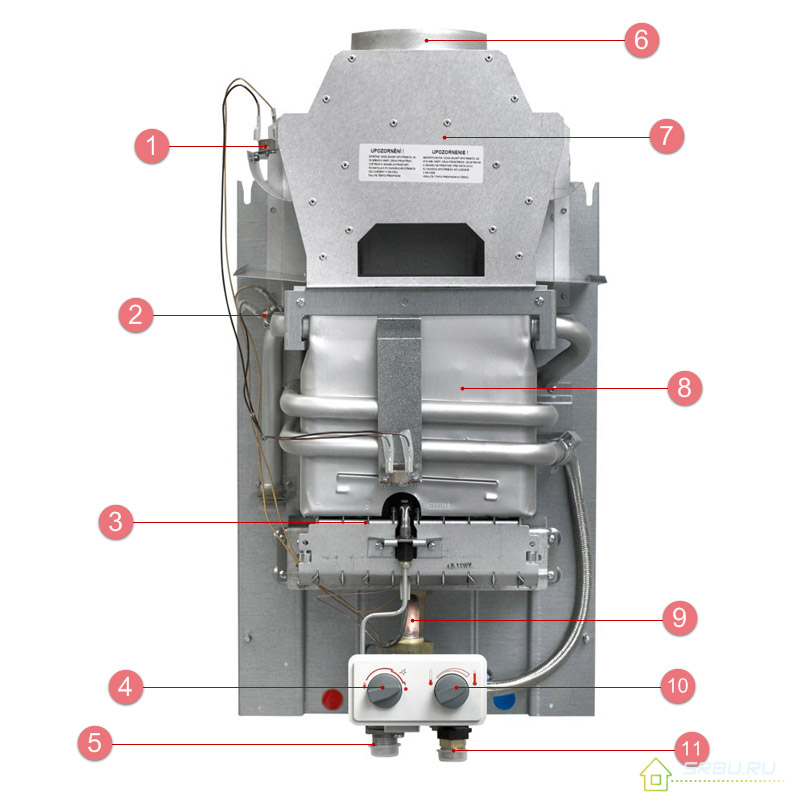
1. Traction detector;
2. Overheat detector;
3. Gas-burner;
4. Gas flow regulator;
5. Hot water outlet
6. Exit for a chimney;
7. Manifold for combustion products;
8. Heat exchanger;
9. Gas pipe;
10. Water intake regulator;
11. Outlet for cold water.
The heat source in gas water heaters is the burner flame. Most devices sold today are equipped with an open combustion chamber, into which air flows directly from the room. The reason is commonplace. The main consumers of this equipment are owners of houses built for a long time. There is a gas pipeline in these houses, but there is no hot water supply system.
New equipment is actually purchased to replace previously used gas water heaters. The latter, as a rule, were equipped with just an open combustion chamber, which means that the house already provides everything for their operation, including a single-channel chimney with the required throughput.
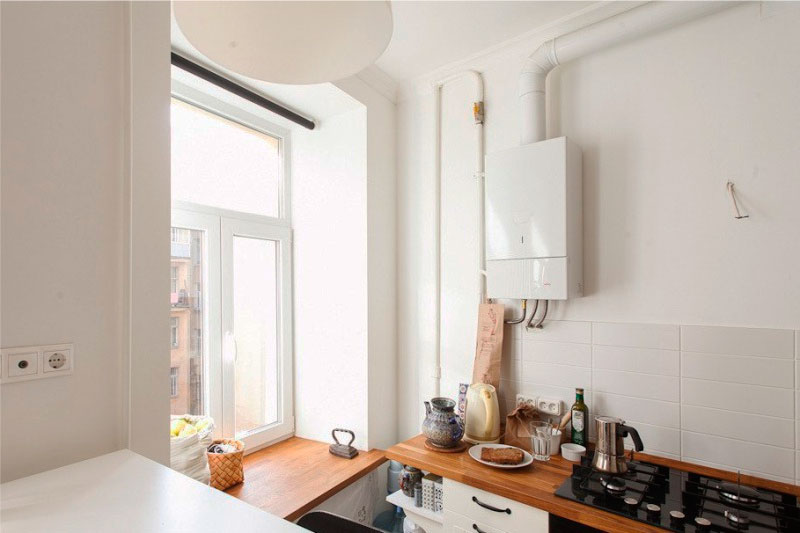
Engage in thorough alterations, mounting the inlet duct or replacing the chimney pipe with a coaxial, the owners, as you know, do not make much sense. In addition to the ease of installation, heaters with an open combustion chamber have other advantages: firstly, they are cheaper, secondly, they are energy independent, while models with a closed chamber require electricity to operate the built-in fan.
All gas water heaters differ in the method of ignition. The simplest option is a piezo ignition with manual control: I pressed a button - a spark jumped through, the ignitor caught fire. Electric ignition is more convenient, although the heaters equipped with it are a little more expensive. In this case, ignition is performed automatically when the mixer is opened and the corresponding sensor is triggered.
For electric ignition, it is not always necessary to connect to the mains. In some models of water heaters, replaceable batteries or a small turbine that generates current when rotating under pressure of water serve as an energy source.
Adjusting the power and temperature of water heating in a gas water heater is usually carried out by turning the mechanical regulators located on the body of the device. It should be borne in mind that a change in water pressure in the system will inevitably lead to a drop or increase in its outlet temperature. That is why many water heaters are equipped with modulating burners. The latter react to fluctuations in water flow, while changing the heating power.
Power modulation can be mechanical and electronic. The action of mechanical modulation is based on a simple physical principle: a change in water flow leads to a change in pressure on the rod, which causes a change in gas flow. Models with electronic modulation more accurately support the set water temperature, because in them the change in the heating power is carried out by the command of the electronics processing the data received from the temperature sensor.
Electric water heaters
In electric water heaters, water is heated by means of a heating element. In most models, there is not one, but two heating elements: in storage heaters, the second heating element is used when it is necessary to heat water faster, in flow heaters it allows you to increase the temperature of the outlet water.
Instantaneous electric water heater
Flowing electric water heater in terms of design is quite simple.Inside the housing of such a device is a heating unit. This can be one or more heating elements or an uninsulated wire in a heat-resistant fluoroplastic casing. If there are several heating elements, then they can be connected alternately or simultaneously. The simultaneous operation of several heating elements allows you to increase the temperature of the outlet water.
Instantaneous electric water heater
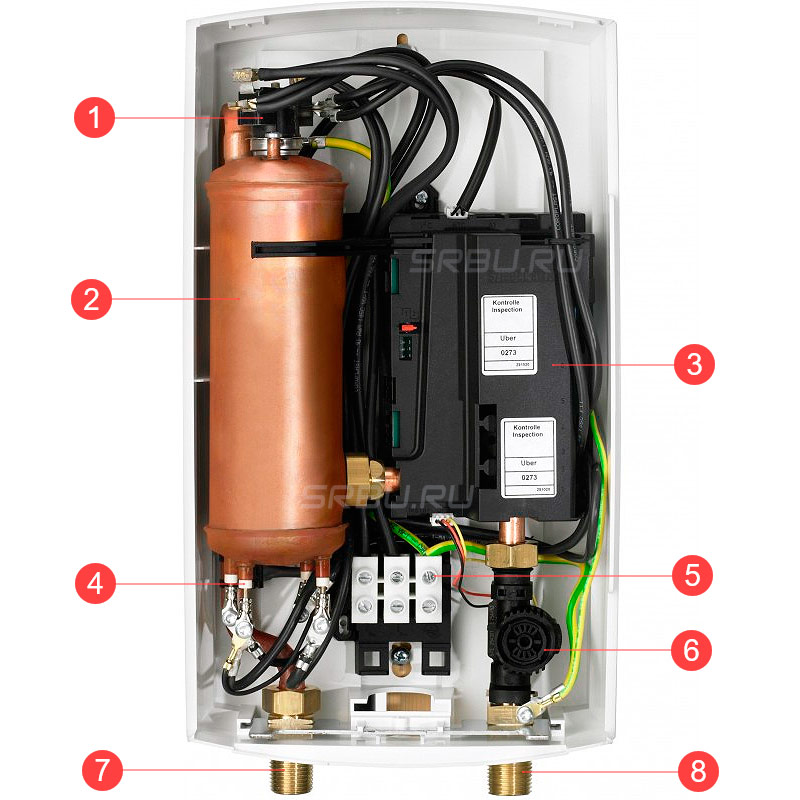
1. Thermal safety switch.
2. Copper heating unit.
3. Electronic control unit.
4. Temperature sensor.
5. Terminal block for wiring.
6. Flow sensor.
7. Hot water outlet.
8. Cold water inlet.
To control the temperature of the water leaving the instantaneous water heater, either a hydraulic or electronic system can be used. In the first case, the water temperature directly depends on its flow: the shorter the contact time of the water with the heating element, the less heat, of course. However, it should be borne in mind that heating is carried out only with sufficient water flow: if the flow is too small, the heating elements will not turn on.
To adapt to such a system is quite difficult: when the pressure changes, the water can become too hot or, conversely, too cool. In expensive models of water heaters, an electronic temperature control system is usually used. Such a system analyzes the temperature of cold water, its pressure and other parameters, and on the basis of this regulates the heating power and water flow. Electronically controlled water heaters are more convenient, but certainly more expensive than their hydraulically controlled counterparts.
Depending on whether the water supply is blocked at the inlet to the heater or at the outlet of it, all instantaneous water heaters are divided into pressureless and pressure. The power of the first is relatively small (2-6.5 kW). Their low productivity (2-6 l / min) allows them to "serve" only one point of the drawdown. As a rule, such heaters are used as backup sources of warm water, for example, in case of planned outages of a centralized hot water supply system.
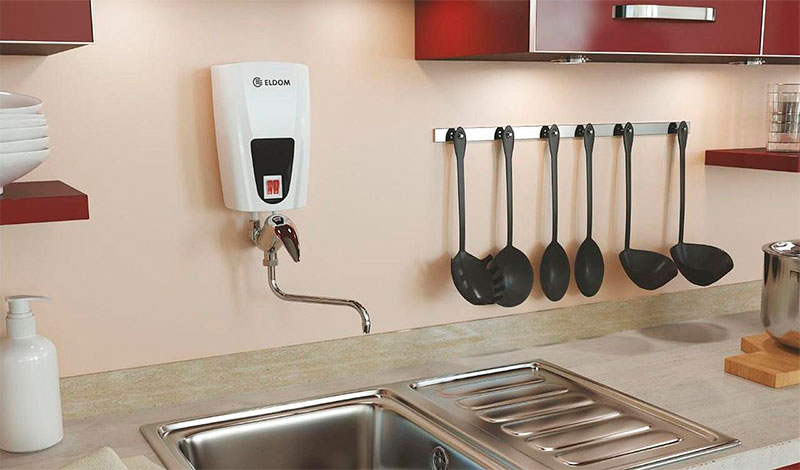
Non-pressure electric water heater.
Pressure water heaters, on the contrary, usually serve as the main generators of hot water in homes where there is no centralized hot water system. They are integrated in a pressurized water supply network and are able to provide several points of drawdown, such as a bathroom and kitchen, with hot water at once. Of course, their power is significantly higher than that of non-pressure ones.
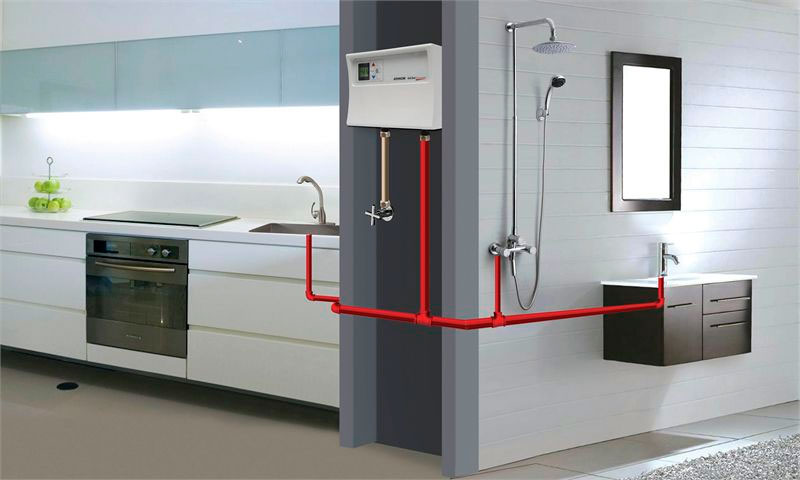
Pressure electric water heater.
Accumulative electric water heater
Accumulative electric water heaters are fundamentally different from instantaneous. Water heating with this device is not carried out “in real time”: when using the residents of the house with hot water, its prepared reserve is consumed. This means that, firstly, the storage water heater does not need to develop more power, and, secondly, its design must have a tank for storing hot water (in the same tank it also heats up).
The device of the storage electric water heater
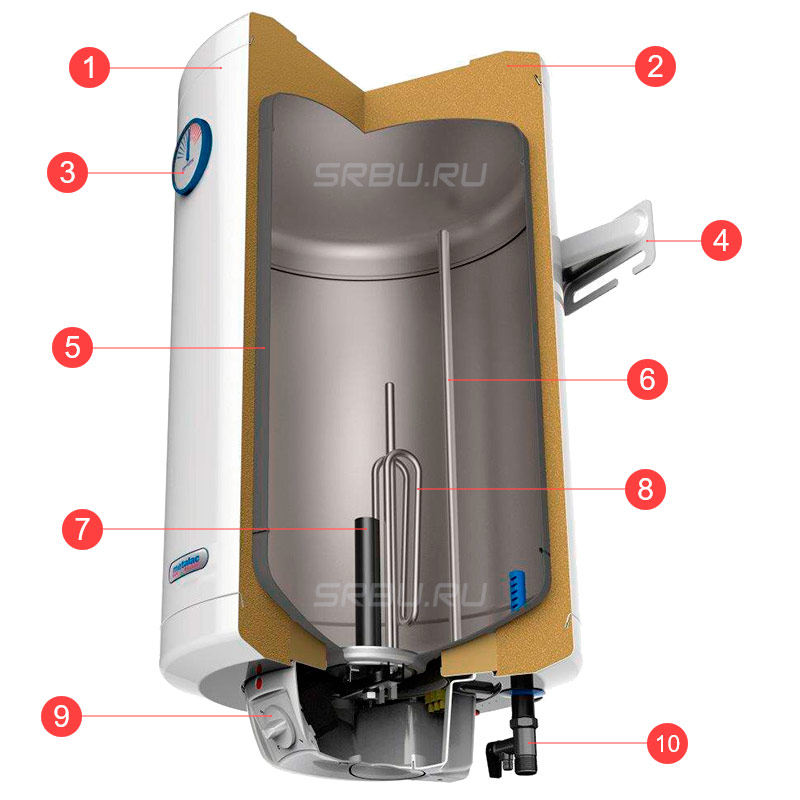
1. The outer casing.
2. Thermal insulation.
3. Temperature indicator.
4. Wall mounts.
5. Hot water extraction pipe.
6. Inner tank.
7. TEN.
8. Magnesium Anode
9. Temperature adjustment knob.
10. The supply of cold water.
A water heater tank is made, as a rule, of steel with an enamel or glass-ceramic coating, designed to protect the walls from corrosion. Less commonly, the tank is made of stainless steel, and in models with a volume of less than 30 liters, sometimes you can find tanks made of copper or plastic. The main requirements for the tank material are sufficient mechanical strength and heat resistance, as well as chemical inertness, which guarantees good water quality and lack of tendency to corrosion.
The service life of a water heater primarily depends on the quality of manufacture of the tank.It makes no sense to repair or replace a leaky tank: you have to send the entire heater to a landfill. Some manufacturers give a separate warranty on the internal tank. The presence of such a guarantee may serve as an indirect indication that the manufacturer did not try to save money by making cheap materials or by simplifying the technology of welding and applying enamel.
Often inside the case there are not one but two tanks connected by overflow tubes (a simpler option is one tank, but separated by a partition with several openings). Water is supplied to one tank, and taken from another. Such a system provides a more uniform mixing of the incoming cold water with the remaining hot.
The task of the storage water heater is not only to heat the water, but also to preserve its heat. That is why the space between the outer casing and the inner tank is filled with polyurethane foam, which acts as a heat insulator. A layer of this material a few centimeters thick is enough for the temperature of the prepared water to decrease no faster than one degree per hour.
Inside the tank there are heating elements - heating elements. In most models there are two of them: only one works in the economical mode, but if you need to heat the water quickly, the second comes to his aid. So that the TEN tubes do not corrode and are not covered with a layer of scale, they are usually placed in a special enameled flask (a similar technology is called “dry” TEN).
In addition to the heating elements in the inner tank, you can also find a magnesium anode in the form of a rod connected to the tank wall. This element is not used in flow-through, but is available in almost all storage water heaters. Its purpose is protection against corrosion of metal structural elements that are in contact with water, and primarily the walls of the tank in places of damage to the enamel coating.
The storage water heater control system can be mechanical or electronic. If the water heater operates year-round, and not from case to case, of course, electronics will be preferable, because it makes it possible to program the process of heating water (for example, heating to a given temperature by a certain time or heating at night if a two-rate electricity meter is installed in the house), and also set the temperature with high accuracy (usually in increments of 1 ° C).
Next, we compare the water heaters presented above for a number of characteristics.
Dimensions and weight of the device
From the point of view of dimensions and weight, storage water heaters significantly lose to their flowing "brothers." The latter are lightweight and compact.
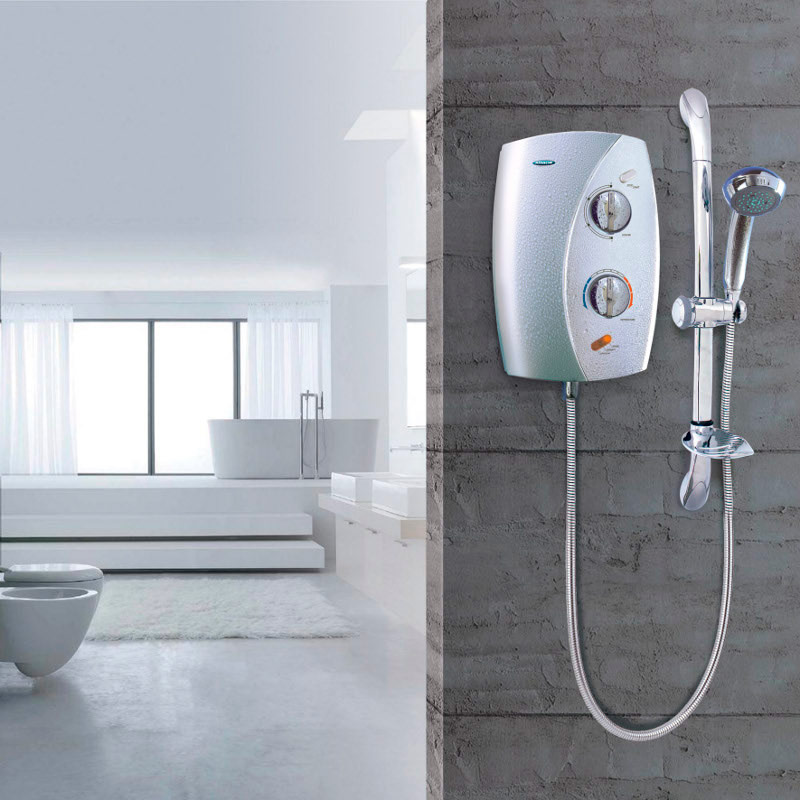
Accumulative, due to the presence of a volumetric tank, it is sometimes difficult to find a place in the tiny bathrooms or kitchens of many apartments. The greater the supply of hot water a particular storage water heater can provide, the larger it is (and, of course, heavier, especially when it is full).
The tank volume of household appliances can vary in a fairly wide range - from 5-10 to 300-500 liters. Most often, however, only tanks with a volume of 30 to 150 liters are used. A smaller volume is not enough even for washing dishes, a larger one, as a rule, is too large for domestic purposes and conditions.
What kind of water heater to choose? It is believed that a 30-liter tank is more than enough to meet the daily needs of one person. It seems to you that this is not enough? Do not forget, however, that too hot water coming from the water heater needs to be diluted with cold, which means that hot water is not consumed so quickly. In addition, you do not need a tank with a daily supply of water, because this supply is constantly being replenished.
Apparently, when choosing, it makes sense to evaluate what maximum amount of hot water you have to “drain” in a short period of time (as a rule, this happens only when you take a bath or shower).
In short, when choosing a storage water heater according to such a parameter as the size of its internal tank, it is very important to find a “middle ground”. Buy a model with a tank too small - someone from the household will have to wait until a new portion is warmed up. Buy a heater with an excessively large tank - it will take up a lot of useful space and will consume unreasonably a lot of electricity.
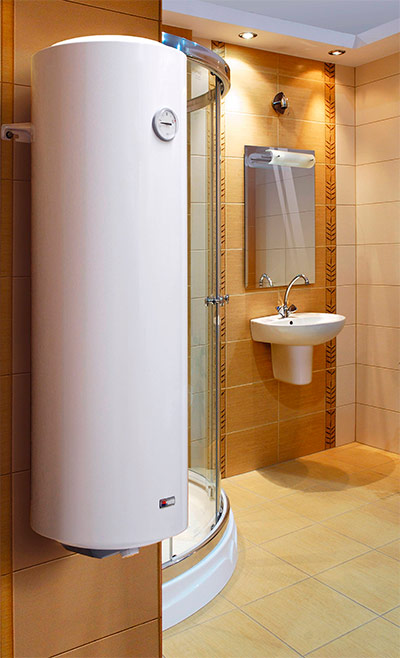
Models with a volume of up to 150 l are designed for wall mounting. At the same time, manufacturers, as a rule, offer horizontal and vertical modifications of such water heaters, characterized by the arrangement of internal tubes and inlet / outlet pipes. There are, however, a few universal models that allow both installation options. For storage water heaters with a tank volume of more than 150 liters, only a floor-mounted installation is possible, since ordinary fasteners are simply not able to support the corresponding weight.
Profitability and cost of water heating
Given the constant increase in prices for electricity and energy carriers, the issue of energy efficiency of a heating equipment is becoming one of the most acute.
Electric water heating is the most convenient and simple solution. But at the same time it is the most expensive. However, given the ease of installation and operation of electrical systems, many users prefer this particular option, turning a blind eye to the inevitable increase in utility bills. If the communications of a house or apartment allow you to use a gas water heater, then this will be the cheapest option for you.
With a pair of "electric - gas" everything seems to be clear. And what will be the result of comparing the flow and storage water heaters?
The main difference between flowing and storage electric heaters lies in the method of heating water, and, therefore, in the nature of energy consumption: flowing spends almost instantly, and storage gradually. It would seem that the amount of electricity spent on heating water should depend only on its volume, and not on the speed of the process. This is true, but for some reason the electricity meter shows different numbers ... It's all about heat loss ...
Instantaneous water heaters are by definition very economical. They heat up exactly as much as you spend (the volume of water remaining in the pipes is small, and it can be ignored in estimates). Heat losses in instantaneous water heaters are so small that they can be safely neglected. This is confirmed by high values of efficiency: for gas models, the efficiency is approximately 90%, for electric ones it is close to 100%.
In the case of storage water heaters, the picture is not so rosy. Energy is spent here not only for heating water, but also for further maintaining the set temperature, because despite the presence of a heat insulator, part of the accumulated heat is still dissipated through the walls of the tank. It would seem that a little is spent per day - 0.5-1.5 kW with a tank volume of 30-100 liters, but a tangible amount will “run” over the year.
In fairness, a small reservation should be made: if a multi-tariff electricity meter is installed in your house, the storage heater can be configured to heat water in “cheap” night time, and then the cost of heating will significantly decrease.
The need for engineering systems
You can install in your house far from every water heater that you liked in the store. The obstacle to this may be a lack of necessary communications or a mismatch of existing requirements for new equipment.
A natural limitation for using a gas water heater is the lack of gas.If a gas pipeline is not connected to your house and you do not have a gas holder, then there can be no question of using a gas heater.
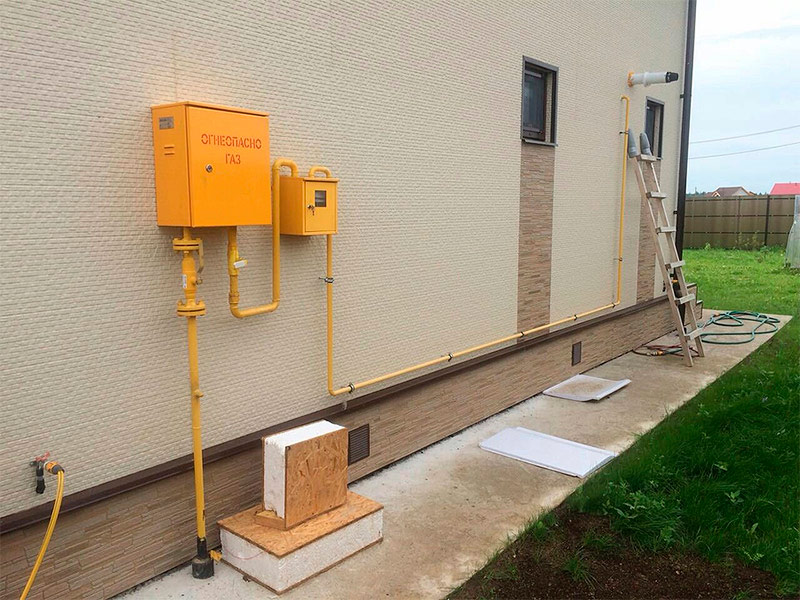
Unlike gas, electricity is in every home. Does this mean that you can use an electric water heater without any problems? Here, it turns out, there can also be pitfalls.
The main limitation for the use of electric instantaneous water heaters is associated with the increased requirements imposed on them by the electric grid. To heat water in real time, the device must release a lot of heat, and for this it needs to consume a lot of electricity per unit time. Even low-power specimens with low productivity, providing heating of 2-3 liters of water per minute, consume at least 3 kW.
If you need a greater flow rate of water, then, accordingly, you need a heater of greater power. The power of flowing electric water heaters produced today varies from 3 to 30 kW. Obviously, such a device when connected will create a significant load on the network, and not everywhere the power supply system will be able to withstand such a load: 5-6 kW is usually the limit, and in older houses it is even less.
Before buying a flowing electric water heater, check with your energy supply organization which electrical equipment what maximum permissible power can be installed in your house / apartment. With a high probability, you will need to replace the wiring before connecting the water heater, but in some cases even this cardinal measure will not help.
It should be borne in mind that instantaneous water heaters, whose power is 10-30 kW, require a connection to a three-phase network of 380 V. Access to the latter is, however, not in every house. Less productive units with a power of up to 6 kW can be powered from a conventional single-phase 220 V.
However, such a heater, like any other equipment with a power of more than 3.5 kW, needs to allocate a separate line with its own circuit breaker. Otherwise, when two powerful electrical appliances (one of which is a water heater) are switched on on the same power line, the network can overload and the machine may operate.
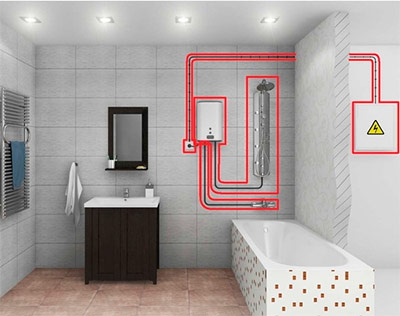
Accumulative electric heaters are the most unpretentious on this list. They “burn” electric energy a little more than flowing ones, but they don’t need much power, because the water in them heats up slowly. For heaters with a tank volume of 30-100 l, the total power of the heating elements is about 2 kW. Such units do not create excessively large loads on the power grid and therefore can be successfully used where flow-through is simply impossible to use. You do not need to redo the wiring to connect the storage heater - it also works fine from a conventional power supply.
The ability to produce the required amount of water at any time of the year
One of the most important characteristics of a flowing water heater is its performance. It is believed that to provide one point of tapping, a heater is needed that produces 5-10 liters of hot water per minute. However, knowledge of the number of liters per minute is not enough. You need to know not only “how much it will heat”, but also “how much it will heat”.
The fact is that the temperature of cold water coming from the water supply system can vary quite a lot depending on the season. The difference often reaches 10-15 ° C. As a result, a heater that works perfectly in the summer and in the winter may simply not be able to cope with its tasks. A user who does not have experience will be very upset to find that in winter a thin stream of hot water flows from his faucet (or not a thin stream, but hardly warm).
We illustrate the above with specific figures. For example, in summer, the inlet water temperature is 20 ° C, and it needs to be heated to a relatively comfortable 30 ° C.The productivity of a 3.5 kW flow heater with such a temperature difference will be about 5 l / min. In winter, the temperature of the incoming water drops to 5 ° C, and, therefore, the temperature difference at the inlet and outlet will not be 10 ° C, but 25 ° C. Under such conditions, the same heater will produce only about 2 liters of warm water per minute - a thin stream, unsuitable for washing in the shower.
From all this it follows that the purpose of small instantaneous electric heaters with a capacity of up to 6 kW is water heating in the summer. For year-round use, especially with the simultaneous connection of several points of tapping, models of greater power are required.
With storage electric heaters, everything is much simpler. Their productivity, of course, also depends on the inlet water temperature: in winter, when the difference between the initial and final temperatures is maximum, the heating time will increase. However, since such units heat water in advance, the user will most likely not even notice a slight increase in the time of their active work.
Flowing gas heaters usually also do not create any particular trouble for their owners. In the process of burning gas, a lot of thermal energy is released, so the performance of gas heaters is large enough to operate them year-round. With such a performance, even in winter you will not have to be disappointed due to the poor pressure of hot water or its low temperature.
Installation complexity
Installation of an electric water heater does not, as a rule, cause any difficulties. However, even if you are confident in your abilities, it will not be superfluous to consult a professional regarding the scheme of connecting to the mains. The device with a power of up to 3 kW can be plugged into a conventional, water-resistant outlet.
If its power exceeds 3 kW, then a cable with a cross section of 2.5 mm is required for connection2 or more, going directly from the switchboard. In this case, a separate residual current device must also be installed (many models are supplied with an RCD built into the housing). Any electric heater must also be grounded.
If you decide to purchase a gas water heater, then be prepared for the difficulties associated with its installation. The self-installation of such equipment is prohibited, otherwise you will be threatened with a loss of warranty and a fine. Moreover, you will also need to obtain permission from the gas service to operate such a water heater.
Service requirement
Instantaneous water heaters practically do not need attention from the owner. If we are talking about a gas heater, then the only thing that may be required from the user is the periodic replacement of the batteries used for electric ignition, if the latter are provided for by the design (such models, as a rule, have an indicator on the control panel warning that the batteries are low )
Storage water heaters require periodic inspection. Manufacturers recommend checking the condition of the heating elements, the integrity of the enamel coating of the tank, the degree of wear of the anode once a year, and if necessary, take appropriate measures. What is the reason for the requirement of such increased attention?
Accumulative heaters, unlike flow heaters, heat water to sufficiently high temperatures, at which scale begins to form intensively. The latter is the reason for the gradual clogging of pipes and tubes, an increase in the rate of reproduction of bacteria and, most importantly, a decrease in the efficiency of the heater. That is why during the annual audit it is necessary to clean the heating elements and the inner surfaces of the tank from loose scale. In general, if the incoming cold water is too hard, it makes sense to install a softening system at least before the heater.
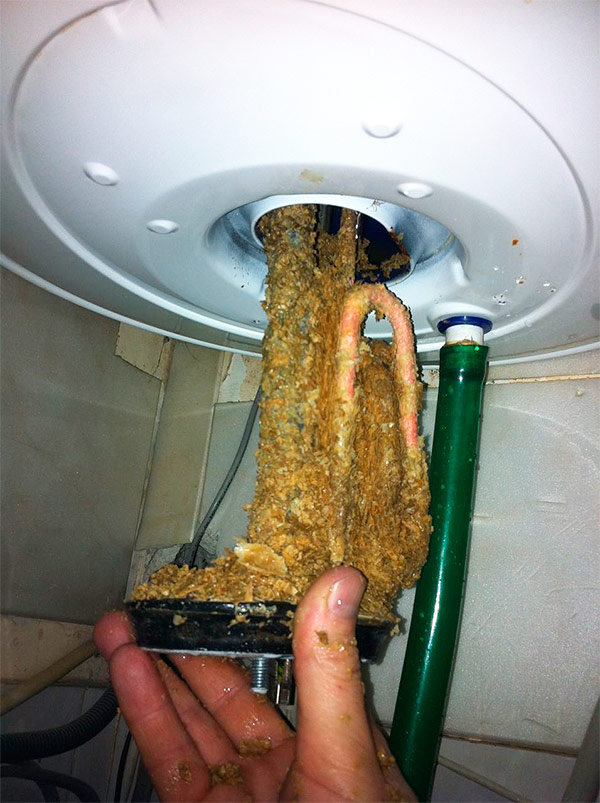
Scale on the heater.
Any storage water heater has a passive magnesium anode.Its purpose is protection against corrosion of the inner surface of the tank in places where defects in the enamel coating appear. Magnesium is a more active metal than iron, therefore, the oxygen contained in the water will react primarily with it, which means that the steel walls of the tank will remain unharmed.
However, "taking fire on itself," the anode gradually dissolves, and therefore, this element should be replaced from time to time. How often - depends on its size, intensity of use of the water heater and water hardness. As a rule, this has to be done once every 1-3 years. By the way, there are also “active anodes” requiring power supply, but non-expendable, however, they are practically not used in household appliances.
Heat and moisture are an excellent medium for the growth of bacteria, so if you do not take any action, the water coming from the water heater may very soon get a rather unpleasant odor. Especially often, such an unpleasant phenomenon is observed in rarely used water heaters, which also warm to a temperature of no higher than 30-40 ° C.
This problem is solved quite simply: you need to heat the water at least once a month to the maximum permissible temperature, ideally close to boiling. If you have an electronically controlled model, such periodic preventive heating can be programmed. If the water heater is used only occasionally, for example, during the shutdown of hot water, then before a long period of inactivity, water from the tank must be drained.
Comparison Table
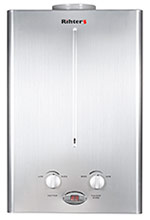 | 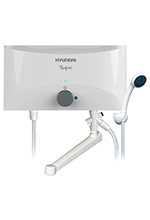 | 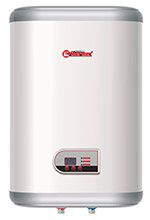 | |||||||
|---|---|---|---|---|---|---|---|---|---|
| Instantaneous gas water heater | Instantaneous electric water heater | Accumulative electric water heater | |||||||
| Dimensions and weight of the device | Average | Small | Big | ||||||
| Profitability and cost of water heating | Low | High | High | ||||||
| The need for engineering systems | Gas supply required | Need good wiring | No special requirements | ||||||
| The ability to produce the required amount of water at any time of the year | The temperature of the incoming water stream does not greatly affect heating | The temperature of the incoming water stream greatly affects the heating. | The temperature of the incoming water stream does not greatly affect heating | ||||||
| Installation complexity | Self-installation is prohibited | Average | Average | ||||||
| Service requirement | Only specialists can service | Maintenance free | Storage tank inspection required | ||||||
In which cases it is advisable to use one or another water heater
So, what kind of water heater to choose? Accumulative or flowing? Gas or electric?
1. A gas heater, as we have already said, is the privilege of residents of gasified houses and owners of gas tanks. Gas is much cheaper than electricity, and therefore many take advantage of their opportunity. Many, but not all. For example, owners of private houses with individual gas heating, as a rule, try to implement a unified system with heating water for domestic hot water from a heating boiler with an indirect heating boiler, if you do not have to pull the domestic hot water pipes to too distant draw points.
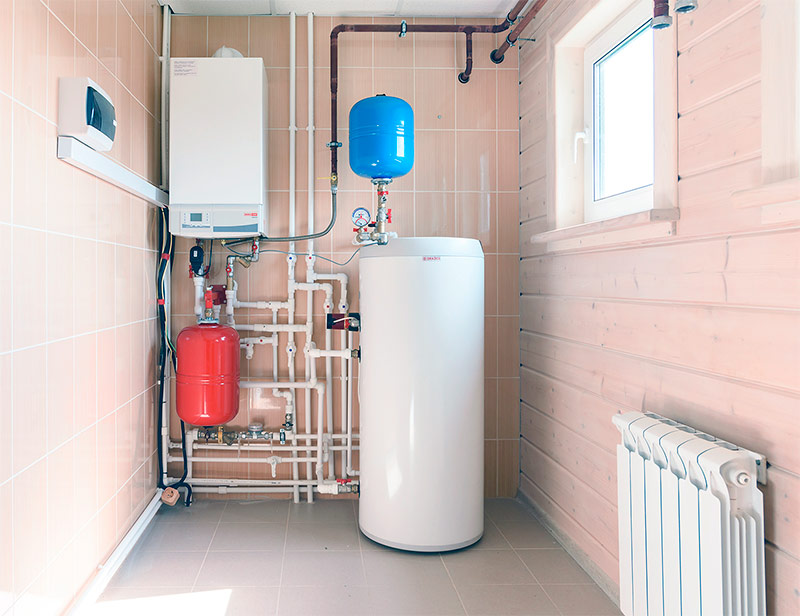
Indirect heating boiler and boiler.
Often, residents of gasified houses and apartments prefer to install an electric heater, simply because it is easier to mount and more convenient to use. In a word, even in houses with gas supply, the likelihood of meeting a gas water heater and other hot water systems is approximately the same.
2. If there is no gas, of course, there isn’t much to choose from - you will have to take an electric heater. But flowing or cumulative - depends primarily on the state of the power grid. If the network is not able to withstand the load created by the flowing heater, the only suitable option for your home is the cumulative one.
If the power supply system at home is able to provide any necessary power, then the choice between flowing and storage models should be based on the estimated intensity of operation of the equipment.Will the water heater only replace the existing centralized hot water supply during periods of planned shutdown, i.e. work for several weeks a year, or will he have to supply you with hot water year-round due to the lack of other sources of the latter?
3. For episodic use, it is more advisable to purchase a flowing water heater. It is compact and, therefore, does not take up too much space in an already tight bathroom. Even a low-cost, relatively low-pressure model of relatively low power will help you survive the several days / weeks allocated for the prevention or repair of the centralized hot water supply system pipeline.
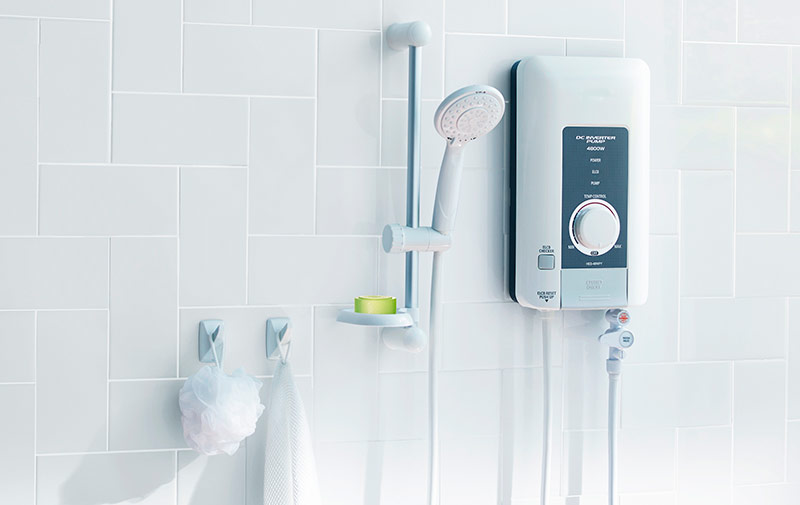
Non-pressurized instantaneous water heater with shower head.
4. In the same case, when the device is assigned the role of a constant source of warm water, the accumulative one may turn out to be more convenient, although not cheaper. In country houses, where, unlike city apartments, the issue of lack of space is not so acute, you can meet a storage electric heater more often than a running one.
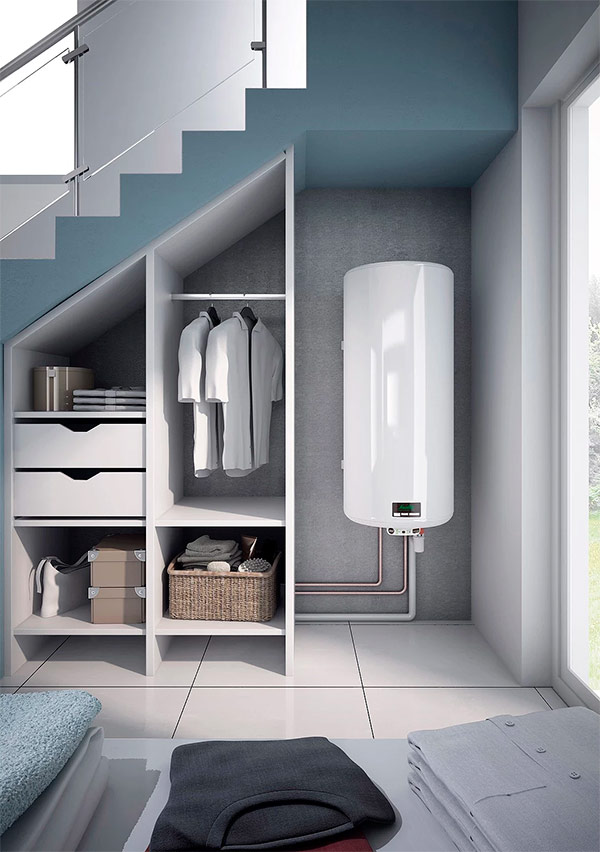
Accumulative water heater of large volume.
As you can see, there is no single answer to the question of which is better - a flow-through water heater or a storage one. This depends on many factors, including the presence or absence of gas, the quality of the wiring, the estimated frequency of use of the heater, the location of the object to be supplied with hot water, your personal preferences, in the end.

